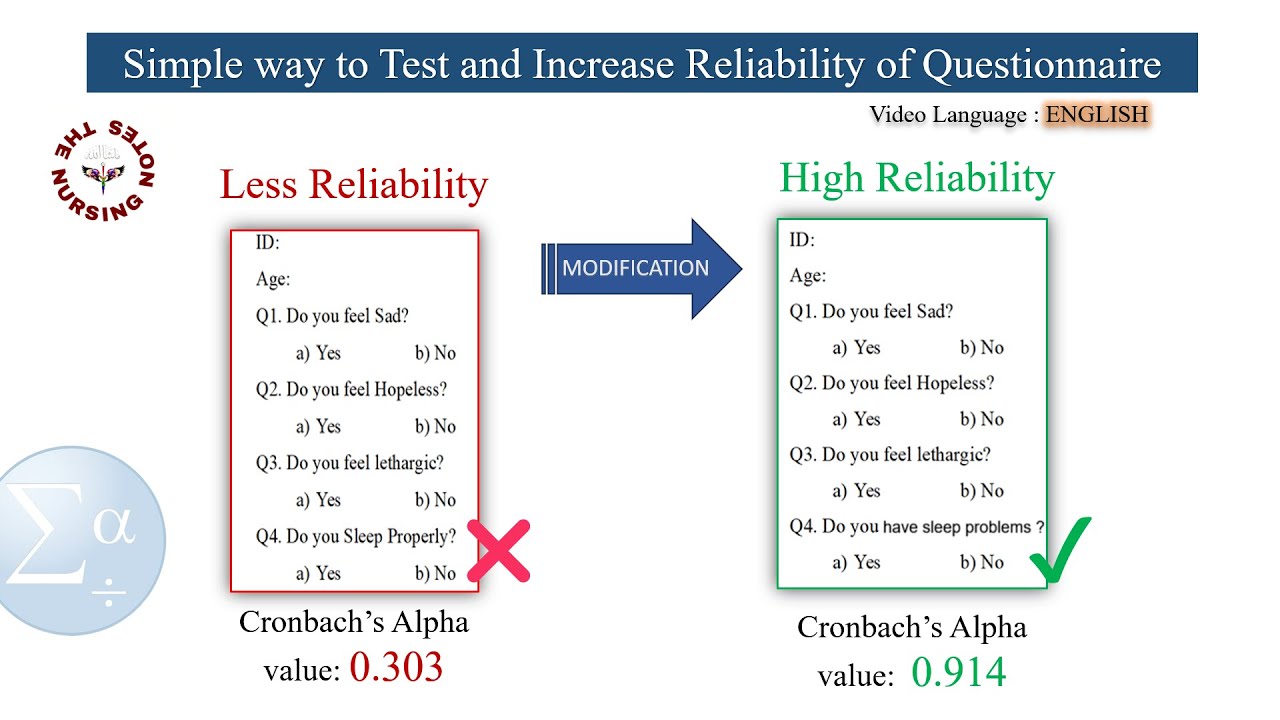Internal Consistency
TLDRThe video script delves into the intricacies of questionnaire design, explaining why surveys often ask the same question in different ways. It highlights the sensitivity of human perception to subtle changes in wording, as demonstrated by the famous Loftus and Palmer study where the use of 'smashed' instead of 'collided' influenced participants' memories of a car crash. The script emphasizes the importance of internal consistency in questionnaire items, which is crucial for accurately measuring the intended latent variables. It discusses the limitations of using a single item scale and the use of coefficient alpha as a common, yet flawed, measure of internal consistency. The video suggests that reporting both alpha and omega statistics, along with their confidence intervals, is a better approach to contextualizing internal consistency.
Takeaways
- 🔍 Questionnaires often ask the same question in different ways to account for human sensitivity to subtle wording changes.
- 🗣️ The way a question is phrased can significantly affect a person's reaction or memory of an event, as demonstrated by Loftus and Palmer's 1974 study.
- 📝 Multiple questions are used to measure a single construct because each question captures a portion of the underlying variable and filters out irrelevant factors.
- 📊 A questionnaire's items should be interrelated to measure a latent variable effectively; internal consistency is key to this.
- 🤔 A participant's responses should be consistent across related items to indicate the validity of the questionnaire's internal consistency.
- ❌ A flawed questionnaire might have items that don't align, which can skew internal consistency calculations.
- 📉 Coefficient alpha, although common, has its limitations and may not always be the best measure of internal consistency.
- 📈 Omega is suggested as a superior alternative to coefficient alpha for estimating internal consistency, despite being more complex to calculate.
- 📋 Reporting both coefficient alpha and Omega, along with their confidence intervals, provides a more comprehensive understanding of internal consistency.
- 🔑 It's important to report on the internal consistency of the scales used in a study, with coefficient alpha being a minimum standard.
- ⚖️ A coefficient alpha value below 0.7 is generally considered inadequate for internal consistency, warranting caution in trusting the scale.
Q & A
Why do questionnaires often ask the same question in different ways?
-Questionnaires do this to account for the sensitivity of humans to subtle changes in wording, which can significantly impact their responses and memories of events or situations.
What is the impact of changing a single word in a question?
-Changing a single word can completely alter the way people remember an incident, as demonstrated by Loftus and Palmer's 1974 study on the use of 'smashed' versus 'collided' in describing a car crash.
What is a latent variable in the context of questionnaires?
-A latent variable is the underlying construct or factor that a questionnaire intends to measure, which is not directly observed but inferred from the responses to multiple related questions.
Why is internal consistency important in a questionnaire?
-Internal consistency is crucial because it measures how interrelated the items in a questionnaire are. High internal consistency indicates that a participant's score on one item is likely to be similar to their score on other items, suggesting that the items are effectively measuring the same latent variable.
What is coefficient alpha and how is it used?
-Coefficient alpha is a statistic commonly used to estimate the internal consistency of a set of items in a questionnaire. It produces a single value, typically aiming to be over 0.7, which is considered the threshold for adequate internal consistency.
What is a potential issue with using coefficient alpha?
-Coefficient alpha has been criticized for various problems, and some researchers argue that coefficient Omega is a superior alternative, despite being more complex to calculate.
Why might a questionnaire item affect internal consistency estimates negatively?
-An item may negatively affect internal consistency if it measures something slightly different from the other items, leading to varied responses that do not align with the overall construct being measured.
What is the recommended approach for reporting internal consistency statistics?
-The best approach is to report both coefficient alpha and coefficient Omega, along with their confidence intervals, to provide a more comprehensive understanding of the internal consistency of the scales used.
What is the significance of a questionnaire item that asks about learning self-motivation through reading?
-This item is designed to measure a specific aspect of self-motivation related to learning, but if a participant does not learn through reading, it may not accurately reflect their overall self-motivation to learn.
Why might a participant score very differently on one item compared to others in a questionnaire?
-A participant might score differently if the item measures a slightly different aspect of the latent variable, indicating a flaw in the questionnaire's design or a mismatch between the item and the participant's experiences or behaviors.
What does it imply if a participant scores high on one item but low on another in a questionnaire?
-This could imply that the items are not measuring the same underlying construct, which would lower the internal consistency of the questionnaire and potentially affect the validity of the results.
Why is it important to report the internal consistency of the scales used in a study?
-Reporting internal consistency is important because it provides information about the reliability of the measures used. It helps readers assess the quality of the study's methodology and the validity of its findings.
Outlines
📝 The Nuances of Questionnaire Design
This paragraph discusses the importance of asking the same question in different ways within a questionnaire. It highlights how humans are sensitive to changes in wording, which can affect their responses and memories. The famous 1974 Loftus and Palmer study is mentioned to illustrate this point, where the use of different verbs in questions about a car crash led to varied recollections of the event. The paragraph also explains the concept of latent variables and internal consistency in questionnaires, emphasizing the need for multiple items that measure the same underlying construct. It critiques the common use of coefficient alpha for estimating internal consistency, suggesting that coefficient Omega might be a better alternative, and stresses the importance of reporting internal consistency statistics for the scales used.
Mindmap
Keywords
💡Questionnaire
💡Sensitivity to wording
💡Loftus and Palmer's study
💡Latent variable
💡Internal consistency
💡Coefficient alpha
💡Coefficient Omega
💡Reporting statistics
💡Unit dimensionality
💡Factor structure
💡Five-point agreement scale
Highlights
Questionnaires often ask the same question in different ways to account for human sensitivity to subtle changes in wording.
Subtle wording changes can significantly impact our reactions and memories, as demonstrated by Loftus and Palmer's 1974 study.
In Loftus and Palmer's study, the use of the word 'smashed' instead of 'collided' led participants to falsely recall seeing shattered glass from the car windows.
Multiple questions in a questionnaire are necessary to measure the underlying construct, known as the latent variable.
A three-item questionnaire for learning self-motivation might include questions about reading, seeking new information, and self-teaching.
Internal consistency is a measure of how interrelated the items in a questionnaire are, and it's quantified using a scale.
Coefficient alpha is a common statistic used for estimating internal consistency, but it has its limitations.
Coefficient Omega is suggested as a superior alternative to coefficient alpha, despite being more complex to estimate.
Reporting both coefficient alpha and its confidence intervals can better contextualize internal consistency statistics.
A coefficient alpha value over 0.7 is conventionally preferred, with anything under considered less than adequate.
If a questionnaire's internal consistency is under 0.7, the scale should be trusted less.
The transcript discusses the flaws of reporting only coefficient alpha and the need for a more comprehensive approach.
A participant's response to individual items can affect internal consistency estimates, highlighting the need for item homogeneity.
The transcript emphasizes the importance of reporting on the internal consistency of the scales used in research.
The use of multiple items in a questionnaire helps to isolate the underlying construct from irrelevant or tangential factors.
A future video is planned to discuss Alpha, Omega, and Confirmatory Factor Analysis (CFA) as varying means for estimating internal consistency.
Unit dimensionality and the underlying factor structure of a scale are important considerations in questionnaire design.
Transcripts
Browse More Related Video

Cronbach's Alpha (Simply explained)

Cronbach's Alpha - Excel

What is Cronbach's Alpha? - Explained Simply

Calculating and Interpreting Cronbach's Alpha Using SPSS

Cronbach's alpha or Coefficient alpha in simple language - DU Professor

Mastering to Increase Cronbach's alpha value | Reliability Test | Simple| using SPSS
5.0 / 5 (0 votes)
Thanks for rating: